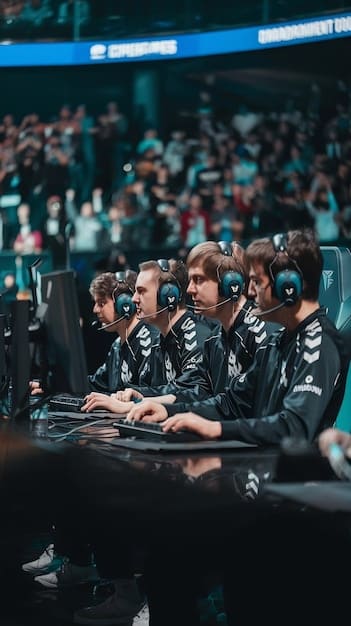FIFA’s eSports Future: Gaming Partnerships & US Soccer Growth

FIFA’s partnership with gaming companies is reshaping the landscape of eSports in US soccer, fostering new opportunities and driving engagement among younger audiences. This collaboration promises to enhance the digital footprint and competitive spirit of the sport.
The world of soccer is rapidly evolving, and with it, the methods of engaging fans and players alike. One of the most significant shifts is the increasing integration of eSports, particularly through FIFA’s partnership with gaming companies. This collaboration is not just about creating digital versions of the beautiful game; it’s about crafting a new future for soccer in the US.
How are these partnerships changing the game, and what does the future hold for eSports within US soccer? Let’s dive in.
Understanding FIFA’s Foray into eSports
FIFA, the governing body of world soccer, has made significant strides into the eSports arena. This move recognizes the growing popularity and influence of video games, especially among younger demographics. The integration of eSports into FIFA’s broader strategy is designed to tap into new markets and enhance the overall appeal of soccer.
The Genesis of FIFA’s eSports Strategy
The initial steps involved creating the FIFA eWorld Cup, a platform for the best FIFA players globally to compete. This created a formalized structure for eSports and provided a direct link to the real world of soccer. As interest grew, FIFA began to explore partnerships with gaming companies to further develop and promote this virtual aspect of the sport.
Key Gaming Partners and Their Roles
- Electronic Arts (EA): EA, through its FIFA franchise, is the primary gaming partner. The game itself serves as the foundation for most FIFA eSports events.
- Console Manufacturers (Sony, Microsoft): Partnerships with PlayStation and Xbox help ensure the game is accessible and enjoyable for a broad audience.
- Third-Party Tournament Organizers: Companies like ESL and DreamHack contribute by organizing and hosting FIFA eSports tournaments, expanding the competitive ecosystem.

These partnerships are essential for providing the technology, platforms, and organizational support needed to grow FIFA eSports. They ensure a consistent, high-quality experience for players and viewers alike.
The Impact of FIFA’s Partnership with Gaming Companies on US Soccer
The US soccer landscape is seeing significant changes thanks to FIFA’s ventures into eSports. These partnerships are fostering new opportunities and attracting younger audiences to the sport. It’s not just about playing the game; it’s about building a community and expanding the reach of soccer in America.
Increasing Engagement Among Young Americans
Young Americans are increasingly engaging with soccer through eSports. Unlike traditional sports, eSports offers accessibility and excitement that captures the attention of digital natives, enhancing the appeal of soccer to this important demographic.
The Rise of Competitive FIFA in the US
The US is witnessing a rise in competitive FIFA gaming, with more players participating in tournaments and leagues. This growth is driving interest and investment in eSports, creating a professional pathway for talented gamers and promoting soccer involvement.
Building a Digital Fanbase
FIFA’s eSports initiatives are contributing to the growth of a digital fanbase. These fans actively follow eSports events, engage with online content, and support their favorite players and teams, thereby expanding soccer’s digital footprint in the US.
This increased engagement is translating to greater participation and viewership in traditional soccer, demonstrating the synergistic effect of eSports on the overall sport.
Exploring the Structure of FIFA eSports in the US
The structure of FIFA eSports in the US is multifaceted, involving various stakeholders from professional soccer clubs to grassroots gaming communities. Understanding this structure is crucial to appreciate the depth and breadth of FIFA’s partnership with gaming companies in shaping the eSports scene.
Professional Soccer Clubs Involvement
Many Major League Soccer (MLS) clubs have embraced eSports by creating their own FIFA teams. These teams compete in eMLS, an official eSports league affiliated with MLS, bridging the gap between digital and physical soccer.
Grassroots Gaming Communities
At the grassroots level, numerous local gaming communities host FIFA tournaments and leagues. These serve as breeding grounds for talents and offer amateur players the chance to compete and improve their skills.
eMLS and Official FIFA Tournaments
eMLS stands as a cornerstone of the professional FIFA eSports structure in the US. Alongside official FIFA tournaments, eMLS provides a platform for top US players to showcase their talent and vie for significant prizes.
These structures are vital for creating a cohesive and robust eSports ecosystem, ensuring both professional and amateur players have opportunities to participate and grow.

The Future of eSports in US Soccer: Trends and Predictions
Predicting the future of eSports in US soccer involves considering current trends and potential advancements. Several indicators suggest continued growth and integration, solidifying eSports’ role in the sport’s evolution.
Technological Advancements
Technological advancements, such as VR and AR, promise to enhance the immersive experience of FIFA eSports. These technologies could revolutionize how fans and players interact with the game.
Increased Investment and Sponsorships
As eSports becomes more mainstream, increased investment and sponsorships are expected. Brands recognize the value of reaching a younger, digitally-savvy audience through FIFA eSports.
Further Integration with Traditional Soccer
Expect even greater integration between eSports and traditional soccer, with more collaborations between MLS clubs and eSports teams. This will create a more unified and engaging soccer experience for fans.
These trends indicate that eSports will continue to play a pivotal role in the future of US soccer, driving growth and attracting new audiences.
Challenges and Opportunities for FIFA’s eSports Growth in the US
While FIFA’s partnership with gaming companies presents numerous opportunities, there are challenges to address for sustainable growth in the US. Overcoming these hurdles is vital to unlock the full potential of eSports and ensure its lasting impact on soccer.
Addressing Concerns about Regulation and Integrity
Ensuring fair play and maintaining the integrity of eSports competitions are crucial. Clear regulations and oversight are necessary to prevent cheating and maintain trust among players and fans.
Expanding Accessibility and Inclusivity
Efforts to expand accessibility and inclusivity are essential to reach a broader audience. Lowering barriers to entry and promoting diversity will make FIFA eSports more welcoming to all.
Navigating the Competitive Landscape
The eSports landscape is highly competitive. FIFA needs to differentiate itself and innovate continuously to stand out and attract top talent and viewership.
By addressing these challenges, FIFA can capitalize on the immense opportunities and pave the way for a vibrant and inclusive eSports future in US soccer.
| Key Point | Brief Description |
|---|---|
| 🎮 eSports Growth | Rising popularity among young Americans. |
| 🤝 Gaming Partners | EA, Sony, Microsoft driving FIFA eSports. |
| ⚽ MLS Involvement | MLS clubs create FIFA teams for eMLS. |
| 🔮 Future Trends | VR/AR, more investment, soccer integration. |
FAQ
These partnerships provide the technological platforms, marketing expertise, and organizational structure needed to professionalize and expand eSports globally.
Key partners include Electronic Arts (EA), console manufacturers like Sony and Microsoft, and tournament organizers such as ESL and DreamHack.
Many MLS clubs have created their own FIFA teams that compete in eMLS, an official eSports league affiliated with MLS, bridging the gap between digital and physical soccer.
Challenges include addressing concerns about regulation and integrity, expanding accessibility and inclusivity, and navigating a highly competitive eSports landscape.
Technological advancements like VR/AR, increased investment and sponsorships, and further integration with traditional soccer are expected to significantly impact FIFA eSports.
Conclusion
FIFA’s partnership with gaming companies is revolutionizing the landscape of soccer in the US, ushering in a new era of engagement and competition. By embracing eSports, FIFA is not only appealing to younger audiences but also creating a dynamic ecosystem that complements traditional soccer.
As technology advances and investments grow, the integration of eSports into soccer will only deepen, promising an exciting future for the sport in the United States.





